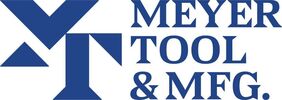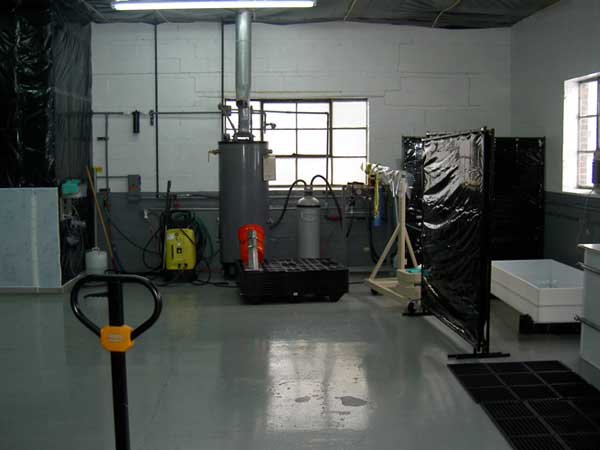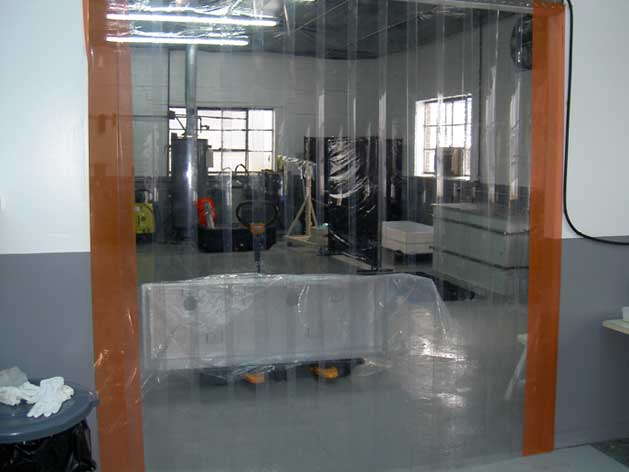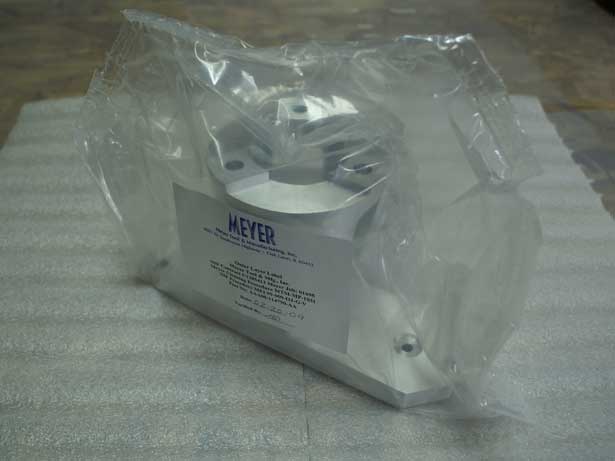Call: 708-425-9080
Cleaning Aluminum for Vacuum Applications
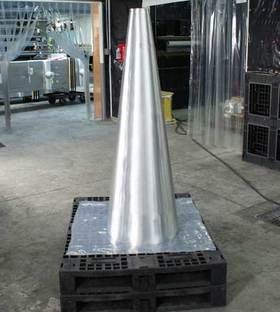 Cleaned aluminum cone.
Cleaned aluminum cone.
The use of aluminum for the construction of vacuum and ultra-high vacuum systems has become widespread in recent years. The methods used to clean aluminum for vacuum service have evolved, minimizing or eliminating the use of chlorinated hydrocarbons, CFCs and other hazardous chemicals. The aluminum alloys routinely employed for vacuum service are 6061, 6063 (extrusions), 2219 (commercial aluminum Conflat™ flanges) and where high strength is needed and tempering is to be avoided 5052, 5083 and 5086. The chemical composition of the alloy will affect the cleaning process.
The nature of the cleaning process and the degree of cleanliness required depends upon the application. In many UHV applications eliminating carbon from the surface is a priority because carbon can combine with other elements to contribute to outgassing. In other applications the elimination of fine particle contaminants is an important issue. For routine purposes (an isolation vacuum, for example) simply wiping the surface down with isopropyl alcohol or acetone to remove gross deposits of cutting oils left by machining is normally sufficient. For UHV applications more elaborate methods are required.
Aluminum is a highly reactive element and forms an oxide layer immediately on exposure to air or water. This oxide layer is frequently removed by etching the aluminum surface in a strong alkaline solution (such as potassium hydroxide). Depending on the alloy, the etched surface may be left with a layer of “smut”; finely divided alloying elements that were not removed by the alkaline etch. Smut formation occurs to a greater degree in alloys having a higher fraction of alloying elements such as copper or silicon. The 2219 alloy, a high-strength, weldable aluminum alloy used to produce commercially available knife-edge vacuum flanges, tends to accumulate smut more rapidly than the 6000 series aluminum alloys due to its relatively high concentration of copper. The traditional method of cleaning an aluminum surface would often start with an organic vapor degrease to remove gross deposits of oil. The next step would be an alkaline etch followed by an acid dip (typically with a mixture of nitric and hydrofluoric acids) to remove the smut. This procedure is not practical for large chambers where a spray cleaning process is required. This was a motivating factor in the development of new cleaning methods.
The first step in the cleaning process is the removal of oil or other deposits left by machining and handling. Thorough washing with a mild detergent can be as effective as organic vapor degreasing. An ultrasonic bath or high pressure spray is often used to aid in initial cleaning with detergent. The second step in the cleaning procedure seeks to modify the oxide layer on the aluminum surface. This is particularly important in UHV applications employing extruded aluminum. When aluminum is extruded by standard processes the oxide layer that forms on the surface tends to be a relatively thick (20nm), porous mixture of magnesium and aluminum oxides which can trap gas and contaminants. Traditionally, this layer has been removed by a mild alkaline detergent (Almeco 18) or a sodium hydroxide solution and then allowed to reform as a thin, dense aluminum oxide layer. A second treatment with an enhanced potassium hydroxide solution (Amklene) was also sometimes used following the mild detergent treatment; however, there is disagreement as to the effectiveness of this step. In many systems, alloy 2219 and a 6000 series alloy are welded together and must be cleaned together. Smut formation on the 2219 alloy may be avoided by reducing the bath temperature or by using Citrinox (a citric acid based cleaner) to remove the copper smut after etching. Some of the cleaning methods which are recently or currently in use are summarized in Table 1.
Table 1. Comparison of processes to clean aluminum for vacuum service.
The nature of the cleaning process and the degree of cleanliness required depends upon the application. In many UHV applications eliminating carbon from the surface is a priority because carbon can combine with other elements to contribute to outgassing. In other applications the elimination of fine particle contaminants is an important issue. For routine purposes (an isolation vacuum, for example) simply wiping the surface down with isopropyl alcohol or acetone to remove gross deposits of cutting oils left by machining is normally sufficient. For UHV applications more elaborate methods are required.
Aluminum is a highly reactive element and forms an oxide layer immediately on exposure to air or water. This oxide layer is frequently removed by etching the aluminum surface in a strong alkaline solution (such as potassium hydroxide). Depending on the alloy, the etched surface may be left with a layer of “smut”; finely divided alloying elements that were not removed by the alkaline etch. Smut formation occurs to a greater degree in alloys having a higher fraction of alloying elements such as copper or silicon. The 2219 alloy, a high-strength, weldable aluminum alloy used to produce commercially available knife-edge vacuum flanges, tends to accumulate smut more rapidly than the 6000 series aluminum alloys due to its relatively high concentration of copper. The traditional method of cleaning an aluminum surface would often start with an organic vapor degrease to remove gross deposits of oil. The next step would be an alkaline etch followed by an acid dip (typically with a mixture of nitric and hydrofluoric acids) to remove the smut. This procedure is not practical for large chambers where a spray cleaning process is required. This was a motivating factor in the development of new cleaning methods.
The first step in the cleaning process is the removal of oil or other deposits left by machining and handling. Thorough washing with a mild detergent can be as effective as organic vapor degreasing. An ultrasonic bath or high pressure spray is often used to aid in initial cleaning with detergent. The second step in the cleaning procedure seeks to modify the oxide layer on the aluminum surface. This is particularly important in UHV applications employing extruded aluminum. When aluminum is extruded by standard processes the oxide layer that forms on the surface tends to be a relatively thick (20nm), porous mixture of magnesium and aluminum oxides which can trap gas and contaminants. Traditionally, this layer has been removed by a mild alkaline detergent (Almeco 18) or a sodium hydroxide solution and then allowed to reform as a thin, dense aluminum oxide layer. A second treatment with an enhanced potassium hydroxide solution (Amklene) was also sometimes used following the mild detergent treatment; however, there is disagreement as to the effectiveness of this step. In many systems, alloy 2219 and a 6000 series alloy are welded together and must be cleaned together. Smut formation on the 2219 alloy may be avoided by reducing the bath temperature or by using Citrinox (a citric acid based cleaner) to remove the copper smut after etching. Some of the cleaning methods which are recently or currently in use are summarized in Table 1.
Table 1. Comparison of processes to clean aluminum for vacuum service.
|
User
|
Aluminum Alloys
|
Method
|
|
Argonne National Laboratory-Advanced Photo Source
|
6063
|
|
|
Argonne National Laboratory-Advanced Photo Source
|
2219
6063 |
|
|
Brookhaven National Laboratory-National Synchrotron Light Source
|
6000 Series
|
|
|
CERN
|
6061
6063 |
|
|
Meyer Tool & Mfg., Inc.
(based on Lawrence Livermore National Laboratory-National Ignition Facility Methods) |
6000 Series &
5000 Series |
|
A newer method for etching and reforming the oxide layer on an aluminum surface employs a phosphoric acid etch followed by cleaning with a detergent. This method was developed for use in cleaning parts for the National Ignition Facility after it was found that the traditional alkaline etch techniques leave an unacceptable level of smut on aluminum surfaces, resulting in fine particle contamination of nearby optical components. This is the technique for cleaning aluminum used at Meyer Tool and Manufacturing, Inc. This technique also results in a thin, dense aluminum oxide layer.
Aluminum chambers have been successfully used in a number of large-scale, demanding UHV applications. Cleaning procedures continue to evolve to meet new demands of cleanliness as well as safety and environmental friendliness.
Aluminum chambers have been successfully used in a number of large-scale, demanding UHV applications. Cleaning procedures continue to evolve to meet new demands of cleanliness as well as safety and environmental friendliness.
Further Reading
- Tests of an environmental and personnel safe cleaning process for Brookhaven National Laboratory accelerator and storage ring components, C.L. Foerster, C. Lanni, R. Lee, G. Mitchell and W. Quade, Journal of Vacuum Science and Technology A 15(3), 731 (1997)
- All-aluminum-alloy ultrahigh vacuum system for a large-scale electron-positron collider, Hajime Ishimaru, J. Vacc Sci. Technol. A 2(2), 1170 (1984)
- X-ray photoelectron spectroscopy analysis of aluminum and copper cleaning procedures for the Advanced Photon Source, R.A. Rosenberg, M.W. McDowell and J. R. Noonan, Journal of Vacuum Science and Technology A 12(4) 1755 (1994)
- Chemical cleaning of aluminum alloy surfaces for use as vacuum material in synchrotron light sources, N. Kaufherr, A. Krauss, D.M. Gruen and R. Nielsen, Journal of Vacuum Science and Technology A 8(3), 2849 (1990).
- Characterization of an effective cleaning procedure for aluminum alloys: surface enhanced Raman spectroscopy and zeta potential analysis, Nerine J. Cherepy, Tien H. Shen, Anthony P. Esposito, Thomas M. Tillotson, Journal of Colloid and Interface Science 282, 80 (2005)
